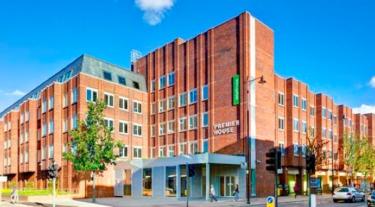Following a dip during the financial crisis, sustainability is climbing back up the corporate agenda. Volatile energy costs, a shrinking security of supply, new environmental regulations and growing consumer awareness are combining to make a compelling business case for action.
In the past, sustainability was seen by some businesses as a means of achieving differentiation or a better reputation, but it will soon be seen by all as a core business necessity.
The implications will be widespread and will affect all areas of business, including workplaces and working practices. New offices are being built to high efficiency standards, and existing building stock is being retrofitted with sustainability in mind. Perhaps more importantly, an increasing number of organizations are putting robust procedures in place to ensure they operate their buildings as efficiently as possible.
At the same time, advances in information and communications technology continue to allow new, more flexible ways of working. While sustainability is not always the main driver behind these innovations, it can be an attractive side-benefit.
The practical question many businesses are now grappling with is: What will sustainability mean for me and my workforce? In some ways, the answer is not much, because sustainability often means doing the same as before but more efficiently. But in other ways, improving sustainability could result in significant changes to business operations and management processes.
The Carbon Trust has identified five potential changes to workplaces and working practices with sustainability benefits. Each has varying likelihoods and levels of disruption.
1. Energy efficient equipment will become the norm
Likelihood: High
Disruption: Low
The business case for energy-efficient lighting, heating and other equipment is already strong. As energy prices continue to rise and equipment performance continues to improve, it will only get stronger.
Government regulations and incentive schemes are encouraging businesses to better understand how they become energy efficient, as well as helping them to realize those opportunities. The combined impact of rising energy prices and government action means that high-performing energy-efficient equipment will soon become the default choice for all businesses.
This accelerated uptake of energy-efficient equipment will only have a minimal impact on the workforce, however. For the most part, the purpose of this equipment is simply to perform the same task more efficiently, so the disruption to workers will be limited.
2. Offices will become smarter
Likelihood: High
Disruption: Low
Office buildings of the future will not only be more energy and resource efficient than today’s buildings, but they will also be smarter. Buildings will use sensors and control systems to adapt to changing weather conditions and occupancy levels in real time.
This will take place as part of a wider move towards integrated smart city networks that continually monitor and optimize energy supply and demand across a city. The practical result of this is that lighting, heating, cooling and ventilation will be maintained at optimum levels at all times, resulting in the win-win outcome of lower energy consumption and better working conditions.
As with energy efficient equipment, smart technology won’t necessarily be particularly noticed by employees, but will help to create a more comfortable working environment with better lighting and thermal comfort, both of which can contribute to improved productivity.
3. Occupancy levels will rise
Likelihood: High
Disruption: Low
One of the easiest ways for businesses to become more energy efficient is to occupy their offices more densely. This can be achieved through a variety of methods, such as open plan hot-desking areas. The privacy of a corner office will soon become a thing of the past.
This may result in individual buildings’ energy consumption rising, but consumption per employee and therefore overall businesses’ energy consumption will fall. Done well, there is no reason why more densely occupied offices should be less pleasant working environments, especially when combined with flexible working practices.
This approach offers businesses a longer-term opportunity to save money on commercial property and reduce business rates. There is, however, a need to consider how it will impact on team and management structures. Management expectations and targets could become more focused on output rather than process, helping to overcome the perception that staff are less productive outside the workplace. Similarly new methods of building team culture through virtual interaction may need to replace the bonding that takes place at the water cooler and coffee machine.
4. Working practices will become more flexible
Likelihood: Medium
Disruption: Medium
We’ve heard grand pronouncements about the rise of the virtual office for years now, but most people spend the majority of their time working as if they were still chained to desk phones, filing cabinets and fax machines. According to the TUC, only 62,000 additional people worked from home regularly in the U.K. over the past year, with the rate of growth only just above the overall rise in employment.
That said, there’s no doubt that communications technologies are enabling many employees to take a more flexible approach to working. There is every indication that this trend is set to continue as broadband and mobile Internet get faster and more accessible, and more data and systems are hosted in the cloud.
In general, homeworking provides both environmental and cost-saving benefits for organizations when well-implemented. It has a particularly strong impact where employees commute by car and where there is the potential to rationalize office space. However, it should be noted that in some circumstances, particularly where offices are energy- and space-efficient and where staff generally commute by public transport (for example in central London), home-working could actually lead to an overall increase in carbon emissions. It is therefore vital to examine the specific situation of a business and its employees in order to properly understand the potential impacts.
5. Businesses may relocate
Likelihood: Low
Disruption: High
In some extreme cases the direct impacts of climate change, such as rising sea levels, will mean that some businesses will have no choice but to relocate. The impacts are likely to be relatively small within the U.K. But according to a recent report backed by a number of U.S. economic heavyweights, including Michael Bloomberg and Hank Paulson, between $66 billion and $106 billion worth of existing U.S. coastal property could be below sea level by 2050, with the greatest impact on the Atlantic and Southeast coasts.
In other cases, businesses may find that changing city landscapes, new low-carbon infrastructure and new working practices mean that there is a strong business case to relocate. This could involve moving to more energy-efficient premises, closer to cheaper or more reliable energy sources, or nearer to public transport hubs. Businesses may also find that increased flexible working practices weaken the case for large and expensive center-city offices.
The changes to workplaces and working practices driven by improved energy efficiency and sustainability will be overwhelmingly positive. Buildings will generate fewer emissions, businesses will save money and staff will benefit from improved working conditions. Not everything will be driven by a concern for the environment, but the possibilities opened up by new technologies mean that doing better as a business will frequently do better for the planet at the same time.



